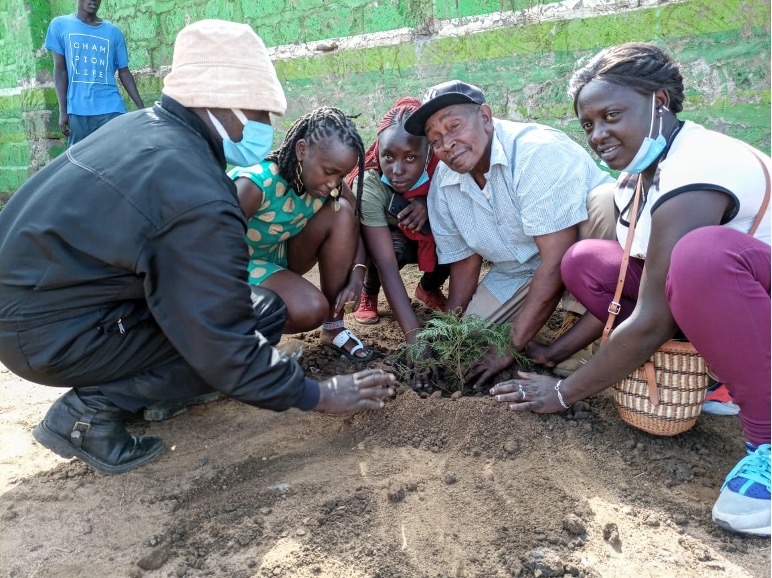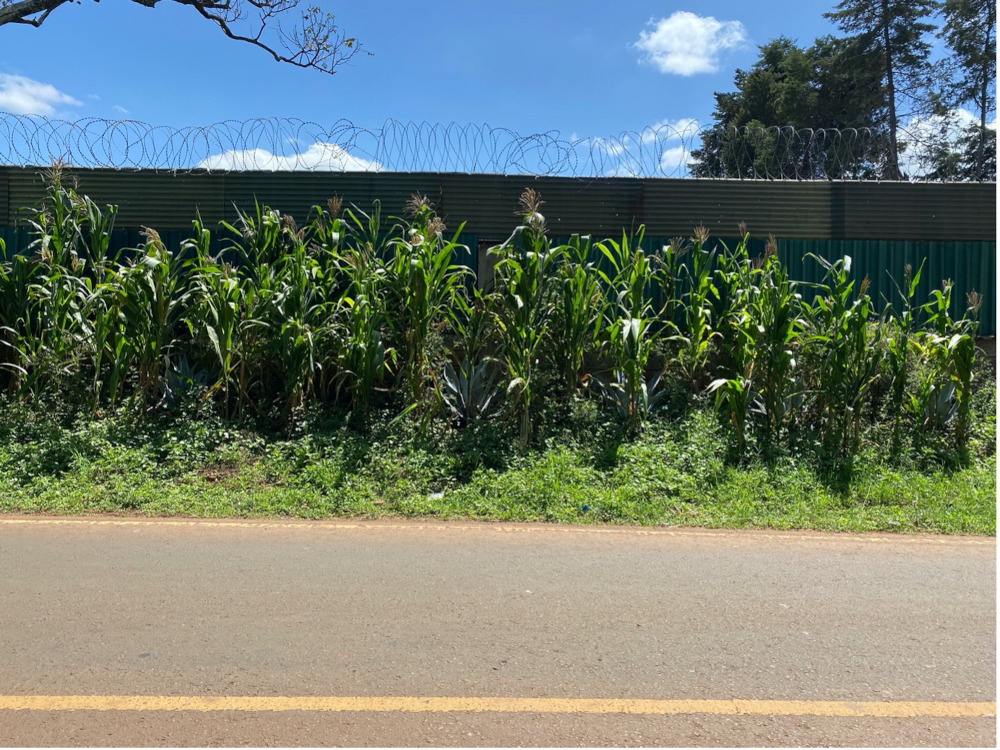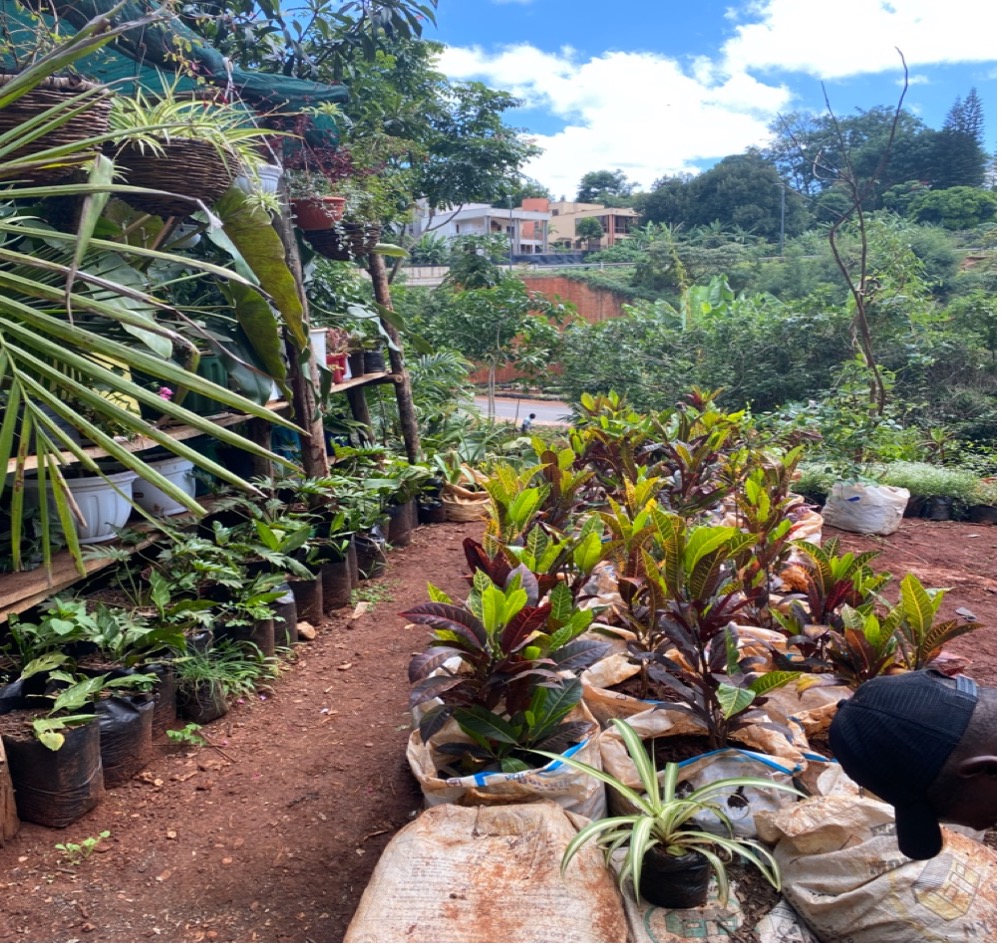Nairobi is not the green city in the sun that the diagrammers of the 1948 ‘masterplan for a colonial city’ wanted it to be. Although this title is aspired to, greatly, it is still some way away from embodying this moniker. At the same time, however, the city is not not green; if you stand on the roof of the Kenyatta International Conference Centre (KICC), a popular tourist attraction, and look towards a Northwest direction, on the horizon are the Ngong Hills, which are linked to the city by the verdant wealthy neighborhood of Karen, bordering the Nairobi National Park. Smaller patches of green – the Arboretum, Uhuru Park and the Karura forest – may also come into view.
In an easterly direction, however, there is more concrete and mabati shacks than green: busy streets, markets, all types of industry. Nairobi’s humans weaving in and out of indoor and outdoor stalls, and multispecies street life—chickens, goats, maize, people. A polluted Nairobi River and its multiple tributaries chugging along, intersecting ‘slum’ settlements, and trying to survive the Anthropocene. And matatu, the (in)famous Nairobi ‘pimped out’ mode of transport, circling in and out of thoroughfares exacerbating both din and dust. Further afield, though not visible from the KICC, is the city’s largest garbage landfill – the Dandora dumpsite.
It is in these parts of Nairobi, not deemed green, in any sense, in both the colonial and postcolonial period, that grounded, intentional environmental futures are being (re)made and imagined. Many youth groups have come together for ‘ecological justice‘ in areas that were historically the ‘native city.’ These efforts in what I refer to in my work as outlaw spaces – areas both intentionally pushed outside of the law and criminalized – involve material and enunciatory measures: labors for environment that are sutured together by a local political education and include cleaning rivers, collecting garbage, growing urban food gardens, recycling plastic, carving our peoples parks in memory of victims of police violence, and the development of ‘young eco warrior collectives and eco schools,’ as but a few examples.
The people animating these efforts are young, with inadequate access to food, education and employment opportunities; direct consequences of the inequality that shapes both city space and our national political economy. In a Nairobi that aspires to be a ‘world–class–city‘ and ‘business hub,’ over 60% of the city’s residents, who live on only 6% of the city’s surface area, are invisibilized in these national aspirations and the formal city practices that spatialize them.
But despite their off-staging, these outlaws are the life force behind grassroots initiatives for a greener Nairobi. In Kayole, Dandora, Mathare, Korogocho, Baba Dogo, young people are changing ‘garbage into gardens.’ The most unlikely of subjects, historically confined to areas intentionally abandoned in both the colonial and postcolonial period, are making their ‘slums’ home to bamboo farms, people’s parks and fruit trees. So much so, that a diversity of wildlife is returning – the other day I saw butterflies.
Certainly, in a city where public and private green spaces are habitually always next to places of wealth, and, more recently, those that are public are being lost, these young people are building ecological lifelines in Nairobi’s ‘informal’ settlements and for the city as a whole.
These actions are not informed by an apolitical environmentalism, an aesthetic preoccupation with green devoid of intersectionality. Rather, this ‘outlaw’ greening is invested with a radical desire to change socio-ecological and material conditions and to question the very logics that consider these areas unworthy of nature and basic rights. Here, bids for the environment – a simple tree – are also steps for food security, access to medicine, shelter, community memorializations and even employment. As a young friend and research interlocutor shared during a focus group:
What we are doing with ecological justice is to claim back public spaces not using violence or protests, but by soft power, by coming up with a solution to this problem. We sweep the dirt; we plant a tree – that’ll be the resistance force that will not go away but one that will remain. This tree signifies our hope. We will use these trees as our resistance against extrajudicial executions; it will symbolise those murdered by the system, as a way to honor them, since the government will never allow us to commemorate those that were killed, since we would do so in anger and maybe become violent. The trees we plant would bring a green environment and this type of environment would be a catalyst for peace here. To symbolise ecological justice, the trees should be fruit trees that our children can enjoy since today we are unable to buy them due to the high cost of purchasing them. If we could use this type of resistance, it would be good as we can transform many areas.
This ecological conscience inspired by diverse fora including indigenous knowledges and actors such as Wangari Maathai – the first Kenyan Nobel Laureate and who received this recognition due to her long standing environmental work with the Green Belt Movement – enables the consolidation of intersectional agendas within simple natural objects such as a fruit tree. Certainly, a tree is a powerful symbol of lives cut short by the police bullets that criminalize poverty, signifying the endurance of life and memory of those and by those who live in a city that does not consider them livable and memorable. And these fruit seedlings also bear witness to and seek to solve the food insecurity that characterizes outlaw spaces, while also offering shelter, a brief repose from a challenging environment.
That is why youth groups such as the Mathare Green Movement promote the following song refrain during their labours; colour ni green:
Colour ni green
[The color is green]
Toka mchanga begin
[From the soil it begins]
Tree life starts from within
Keeping generation generation
This powerful refrain registers the intentional ecological efforts, both enunciatory and material, directed towards bids for inclusive justice in poor urban communities such as theirs.

Family members of victims of police violence plant a tree in a ‘people’s park’ in memory of a victim of extrajudicial killings in Mathare, Nairobi. Photo: Lucy Wambui, 2021. Used with permission.
Highway maize and plant nurseries
Together with these intentional activities – planting trees and eco-schools, for example, are other more surreptitious actions that bring nature back into the concrete seen as ‘development’ [read the proliferating infrastructure projects] in the country. Maize, sukuma [kale] and bean gardens, with no discernible owner, are habitually planted on the sides of highways, on abandoned plots of land, on top of buildings and in between rows of ornamental flowers in all parts of the city. Though no farmer is in sight, there is always a worker somewhere – perhaps an askari [guard] from a neighbouring building – who has staked a claim to this small parcel of land, however tiny, to guarantee their food security.

Maize planted along a road and against a hypersecuritized wall in the upper-middle class area of Westlands, Nairobi. Photo: Wangui Kimari, 2022.
Interestingly, despite a city administration feverishly in pursuit of hyper-modern aesthetics (and maize in roundabouts certainly does not lend itself to ‘world-class’ cityness), and the consistent public panic over the health consequences of tubers being grown ‘in sewage,’ these gardens proliferate and thrive, offering both subversive and much needed harvests. To me, they are reminiscent of the plot gardens tended by enslaved Africans in the Americas and the Caribbean – multispecies ecologies nurtured to “confront, refuse and resist” plantation(ocene) economies of violence. They, undoubtedly, also speak to the persistent land question in Kenya.
There are also the plant nurseries that occupy the sides of roads and wetlands spaces in more prosperous Nairobi neighborhoods, even as those who sell these plants don’t live in these wealthy city regions. Creating unexpected forests by the side of thoroughfares, the outlaw progenitors of these urban mini jungles use knowledge and expertise cultivated in other geographies to nurture both indigenous and foreign fauna for, usually, middle-class gardens. And even though these plants and tree seedlings are for sale, they work to materially and ideologically index green futures. Ultimately, the commitment of the vendors to demonstrating that green is possible in Nairobi, as well as the agential workings of the tree and flower seedlings – soon “blanketing unused roadside and riverbanks” – prompt both the regeneration of the environment and the visions that promote this ideal.

Nickson Luchete’s roadside tree nursery on Loresho road in Nairobi. In the background are both a highway and upper middle-class housing. Photo: Wangui Kimari, 2022.
All of these outlaw initiatives lead to necessary transformation in a country where 20,000 people die of respiratory diseases every year, where food and adequate healthcare is scarce and mental health issues are increasing, yet where the city’s administration only offers entry to the few (militarized) public parks for a fee.
We are also in the country where, after chopping down trees, threatening to hive off chunks of a public park and not undertaking an environmental impact assessment – all for a 26 kilometre expressway dubbed a ‘road for the rich’, the Kenya National Highways Authority (KENHA) will promote creeper flowers on highway pillars as a suitable remedy for the grave environmental externalities of this infrastructure.
In such a context, it is easy to recognize that so much is being done for the ecological futures of Nairobi by these outlaw modes, in outlaw spaces and beyond, even if it is not recognized (nor complemented by action by) city administrations in the postcolonial period, or the (often ironic) United Nations Environment Programme (UNEP) headquartered in the city for over forty years.
Certainly, far from international climate change conferences, formal Intergovernmental Panel on Climate Change (IPCC) processes, or Kenya’s environmental policy and practices exist these invisibilized efforts charting necessary ecological futures in plain sight. Via subjects and modes unforeseen by colonial planners and postcolonial authorities, it is, undoubtedly, the many victims of Nairobi’s environmental apartheid who, through determined ethico-political labours for nature and community regeneration, just may be the very actors who finally turn this city in the sun green.
Wangui Kimari is a junior research fellow at the Institute for Humanities in Africa (HUMA) at the University of Cape Town who continues to work on urban justice issues in Nairobi.
All essays on African Futures
Introduction: Africa’s Urban Futures
Claire Mercer
City of the Future: Lagos and the Afropolitan Imagineering Project of Owambe Urbanism
Grace Adeniyi-Ogunyankin
‘Colour Ni Green’: Ecological Futures in Nairobi Outlaw Style
Wangui Kimari
Aesthetics and the Making of Urban Futures in Luanda, Angola
Claudia Gastrow
Appropriating and Contesting Digital Infrastructural Futures in Urban Africa
Prince K Guma
Land Commodification and Tenure (In)Security: Spotlight on Peri-urban Accra, Ghana’
Divine Asafo
Centring the ‘Urban State’ in African Urban Governance Debates
Liza Rose Cirolia
Related IJURR articles on African Futures
A Shadowy ‘City of Light’: Private Urbanism, Large-Scale Land Acquisition and Dispossession in Ghana
Austin Dziwornu Ablo, & Bjørn Enge Bertelsen
Conceptualizing African Urban Peripheries
Paula Meth, Tom Goodfellow, Alison Todes & Sarah Charlton
Cities, Creativities and Urban Creative Economies: Re‐descriptions and Make+Shifts from Sub‐Saharan Africa
Jenny Mbaye & Andy C Pratt
Identity Building Through Mediation by African Tailors
Sofia Vilarinho & Henri Christiaans
Infrastructure Disruption in ‘Silicon Savannah’: Exploring the Idea of the Creative Class and their Relation to Quality of Place in Nairobi, Kenya
Lauren Rosenberg & Alan Brent
The Creative Night‐Time Leisure Economy of Informal Drinking Venues
Andrew Charman & Thiresh Govender
The Green Masterplan: Crisis, State Transition and Urban Transformation in Post‐Genocide Rwanda
Shakirah Esmail Hudani
The Real Estate Frontier
Tom Gillespie
Day Zero and The Infrastructures of Climate Change: Water Governance, Inequality, and Infrastructural Politics in Cape Town’s Water Crisis
Nate Millington and Suraya Scheba
Urban States: The Presidency and Planning in Luanda, Angola
Claudia Gastrow
Forefronts of the Sharing Economy: Uber in Cape Town
Andrea Pollio
‘The City of Our Dream’: Owambe Urbanism and Low‐income Women’s Resistance in Ibadan, Nigeria
Grace Adeniyi Ogunyankin
Boundary Work: Becoming Middle Class in Suburban Dar es Salaam
Claire Mercer
Silence and Voice in Nigeria’s Hybrid Urban Water Markets: Implications for Local Governance of Public Goods
Charisma Shonté Acey
Global Urban Policymaking in Africa: A View from Angola Through the Redevelopment of the Bay of Luanda
Sylvia Croese
Urban Fortunes and Skeleton Cityscapes: Real Estate and Late Urbanization in Kigali and Addis Ababa
Tom Goodfellow
Sisyphean Dilemmas of Development: Contrasting Urban Infrastructure and Fiscal Policy Trends in Maputo, Mozambique
Gabriella Y. Carolini
Idioms of Accumulation: Corporate Accumulation by Dispossession in Urban Zimbabwe
Beacon Mbiba
‘No Condition is Permanent’: Informal Transport Workers and Labour Precarity in Africa’s Largest City
Daniel E Agbiboa
Building God’s City: The Political Economy of Prayer Camps in Nigeria
Asonzeh Ukah
